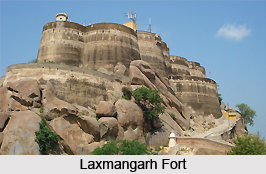 Laxmangarh also known as Lachhmangarh, is a fort town situated in the Sikar district of the western state of India, Rajasthan. It is strategically located on NH 11 and in the north of the district headquarters town of Sikar at a distance of 30 km. The town is a part of the Shekhawati region of Rajasthan. This region is well connected by railways to the other important cities and towns of Rajasthan.
Laxmangarh also known as Lachhmangarh, is a fort town situated in the Sikar district of the western state of India, Rajasthan. It is strategically located on NH 11 and in the north of the district headquarters town of Sikar at a distance of 30 km. The town is a part of the Shekhawati region of Rajasthan. This region is well connected by railways to the other important cities and towns of Rajasthan.
The nearest airport is the Sanganer Airport at a distance of 120 km. The region also has a good road system, which makes it easier to connect to nearby towns by buses, jeeps, and taxis as well. The town is located at a height of 22 metres (728 feet) above mean sea level and geographically between 27.37° North latitude and 76.85° East longitude.
Rao Raja Laxman Singh of Sikar constructed a fort in Laxmangarh and in the nineteenth century this town came into being. Before becoming a town this place was a village by the name of Bergaon, which was the capital of the Meel Jats. Infact Laxmangarh has one of the most impressive forts of the Shekhawati region. The town has adopted the Jaipur city model, which has roundabouts and roads at right angles.
According to the Census report of India, published in 2001, the population of Laxmangarh had a population of 47,288. Males account for 52% of the population and females comprises of 48% of the population. In Laxmangarh, 17% of the population is less than six years of age. The average literacy rate is 59%, which is slightly lower than the national average literacy rate, which is 59.5%. To be specific, the male literacy rate is 70% and the female literacy rate is 47%.
The Laxmangarh Fort is a beautiful piece of fort architecture which is a must visit for all those visiting Laxmangarh. Other than the fort the town is embellished with a number of havelis, which are decorated with Shekhawati fresco paintings. Even now Laxmangarh is a major center of Shekhawati art. Renowned havelis of Laxmangarh are Char Chowk Haveli, Sawant Ram Chokhani Haveli, Mirijamal Kyala Haveli, Bansidhar Rathi Haveli, Kedia Haveli and Sanganeria Haveli. The Ganeriwala Haveli located here is one of the most magnificent palaces of the Shekhawati region. The Radhi Murlimanohar Temple built in 1845 is a famous temple of the town with exquisite sculptures of deities on the external walls.



















